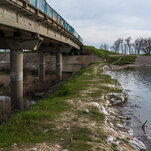Texas Flooding Tragedy: A Community Devastated by Nature’s Fury
The Fourth of July 2025 will forever be remembered not for fireworks and celebration, but for one of the deadliest natural disasters to strike Texas in decades. What began as a typical holiday weekend in the scenic Texas Hill Country became a nightmare of unprecedented proportions when flash floods swept through central Texas, claiming more than 100 lives and leaving communities shattered.
When the Waters Rose
In the early morning hours of Friday, July 4th, residents of Kerr County and surrounding areas were still asleep when nature unleashed its devastating power. The Guadalupe River, normally a peaceful waterway that winds through the heart of Texas Hill Country, transformed into a raging monster. Within less than two hours, the river surged an incredible 26 feet above its banks, rising higher than two-story buildings and reaching levels that veteran meteorologists called unprecedented.
The speed and ferocity of the flood caught nearly everyone off guard. Time-lapse footage from the disaster shows how quickly the waters consumed everything in their path, swallowing a causeway in mere minutes. Cars floated downstream with their headlights still glowing, their horns honking desperately as they were carried away by the torrent.
“If you had seen what July 3 looked like, you would never guess that this was coming that night,” said one witness who watched the catastrophe unfold. “Cars were floating away with the lights on. You could see the lights and you could hear honking.”
The Human Cost
As of the latest reports, at least 118 people have died from the devastating flooding in the Texas Hill Country. Kerr County was hit the hardest, with at least 95 deaths, including 36 children. The toll continues to rise as more than 160 people remain missing, and search teams work around the clock to locate survivors or recover bodies.
The tragedy has particularly devastated the camp community that has thrived along the Guadalupe River for generations. Camp Mystic, an all-girls Christian summer camp that has welcomed children for over a century, suffered catastrophic losses. The camp confirmed 27 members of its tight-knit community were killed, mostly young campers, including 8-year-old Sarah Marsh and the camp’s longtime director, Dick Eastland, who was reportedly swept away while trying to rescue children.
Among the other victims were 68-year-old Jane Ragsdale, who devoted her life to another nearby girls’ camp called Heart O’ the Hills, and 62-year-old Tanya Burwick, whose car was caught in the flood on her way to work. Her son remembered her as someone who “had a heart of gold.” Twenty-seven-year-old Julian Ryan died trying to escape his trailer home, though his fiancé, mother, and 6-year-old son survived.
Heroes in the Darkness
Even as the disaster unfolded, stories of heroism emerged from the chaos. United States Coast Guard rescue swimmer Scott Ruskan from New Jersey is being called a hero after rescuing close to 200 people following flash floods in Central Texas. The 26-year-old Petty Officer was singled out by U.S. Department of Homeland Security Secretary Kristi Noem for directly saving 165 victims as the only triage coordinator at the scene.
Local first responders performed their own acts of courage throughout the night. Kerrville police officers spent the crucial first hours going door-to-door, waking residents and convincing them to evacuate immediately. “They rescued people out of vehicles. They rescued people out of homes that were already flooding, pulling them out of windows,” said community services officer Jonathan Lamb, who noted that the tragedy would have been much worse without their quick thinking.
More than 850 people have been rescued so far — many by helicopters, as aerial crews worked tirelessly to hoist people from flooded RV rooftops and other precarious positions.
The Search Continues
The massive search and rescue operation involves an unprecedented mobilization of resources. More than 20 state agencies are responding to the flood emergency. More than 1,750 personnel and more than 975 vehicles and equipment assets have been deployed. About 17 helicopters were deployed over the weekend to search for missing people.
Search teams have expanded their operations far beyond the initial flood zone, now covering a distance of over 60 miles from Hunt to Comal County. The work is painstakingly slow and dangerous, complicated by difficult terrain, continued rainfall, debris-filled waters, and even snakes displaced by the flooding.
“This is a massive field that is happening. And again, this is unprecedented, unprecedented flood events. So we are still currently in the primary search phase,” explained Dalton Rice, the Kerrville city manager. Each search segment can take one to three hours and cover up to a mile and a quarter of treacherous terrain.
The search efforts have been hampered by well-meaning but problematic sightseers. The Kerrville Police Department issued a plea asking non-residents to stay away, noting that “our first responders were hampered by heavy traffic yesterday, mostly sightseers who are making things worse.” Officials also banned drones from the area because they interfere with official rescue aircraft operations.
A Region Built for Flooding
The devastating flood has raised difficult questions about preparedness and warning systems, particularly given that this region is no stranger to such disasters. Kerr County and surrounding areas are part of what meteorologists call “Flash Flood Alley,” a region in Texas with a long and well-documented history of flash flood events.
The Guadalupe River has experienced major floods repeatedly over the decades, with significant events recorded in 1936, 1952, 1972, 1973, 1978, 1987, 1991, and 1997. The weekend’s disaster evoked particular memories of a catastrophic flood in July 1987 that began as a storm in Mexico and moved across the border, devastating the same area.
Civil and environmental engineering professor Nasir Gharaibeh from Texas A&M University explained that flash floods in this region are caused by a dangerous combination of factors: very intense rainfall in short periods, hilly terrain with steep slopes, and shallow soil that cannot absorb large amounts of water quickly.
Warning System Under Scrutiny
The effectiveness of the warning system has become a major focus of criticism and investigation. While the National Weather Service issued a flash flood watch on Thursday afternoon highlighting Kerr County as high-risk, and flash flood warnings began around 1 a.m. Friday, many question whether the warnings adequately conveyed the severity and immediacy of the threat.
By 4:06 a.m., with river levels rising quickly, it warned of an ongoing “very dangerous flash flooding event.” The official social media pages of the City of Kerrville’s Police Department and Kerr County sheriff didn’t post about the emergency until after 6 a.m.
Some critics have also questioned whether the Trump administration’s earlier cuts to the federal workforce affected the response capability. The National Weather Service lost nearly 600 workers earlier this year due to budget cuts, though some were rehired after public backlash. President Trump denied that the workforce cuts were to blame for any communication failures.
Meteorologists have emphasized the extreme difficulty of predicting what complex weather systems will do and then convincing people to prepare for worst-case scenarios. “We could not anticipate this, despite flood warnings, despite everything going on, there were some things that happened very fast,” said Kerrville City Manager Dalton Rice.
Federal Response and Political Impact
President Trump signed a federal disaster declaration on Sunday to help with recovery efforts, and said he will visit the state this week. Texas Governor Greg Abbott praised the swift federal response, noting that Trump “ensured in less than 24 hours that major disaster declaration was approved, ensuring that state and local governments are going to have more resources to be able to respond to that disaster.”
The Federal Emergency Management Agency has deployed to the ground in Kerr County, and the Texas National Guard has been activated to support search operations. Abbott has pledged that the state “will not stop until every missing person is found.”
A Community in Mourning
Beyond the statistics and emergency response, the flooding has shattered tight-knit communities that have existed along the Guadalupe River for generations. The summer camp tradition in the Texas Hill Country spans over a century, creating bonds between families, staff, and campers that extend far beyond individual summers.
Camp Mystic owner Dick Eastland’s death while trying to save campers has become symbolic of the heroism displayed during the disaster. His grandson described how the longtime camp director fought until the end to protect the children in his care. Similarly, stories have emerged of counselors and staff members who stayed with campers even as the waters rose, providing comfort and protection in terrifying circumstances.
The broader community has rallied to support victims and their families. Hunt Baptist Church has opened its doors to provide free water, food, and clothing to anyone in need. NBC Dallas-Fort Worth and Telemundo Dallas-Fort Worth have partnered with the American Red Cross to coordinate disaster relief donations and support recovery efforts.
Looking Ahead
While the immediate focus remains on search and rescue operations, questions about the future are already emerging. The tragedy has highlighted the ongoing challenges of living in “Flash Flood Alley” and the delicate balance between embracing the natural beauty of riverfront areas and protecting residents from the inherent dangers.
Weather forecasters warn that more rain is expected in central Texas this week, though the threat level appears lower than the conditions that created Friday’s disaster. The Texas Hill Country has a chance for a few isolated showers or storms on Wednesday afternoon. As of early Wednesday, flash flooding is not expected, but it cannot be completely ruled out.
As rescue operations continue and the community begins the long process of grieving and rebuilding, this disaster will undoubtedly prompt serious discussions about flood preparedness, warning systems, and land use policies in flood-prone areas. The heroism displayed by first responders, volunteers, and ordinary citizens offers hope, but the magnitude of the loss ensures that the Fourth of July 2025 will remain etched in Texas memory as a day when nature’s power overwhelmed human preparation.
The search for the missing continues, driven by the determination that every family deserves answers and every victim deserves to be brought home. In the words of Governor Abbott, the state will not rest “until every missing person is found,” a promise that reflects both the scale of the tragedy and the resilience of the Texas spirit in the face of unimaginable loss.










